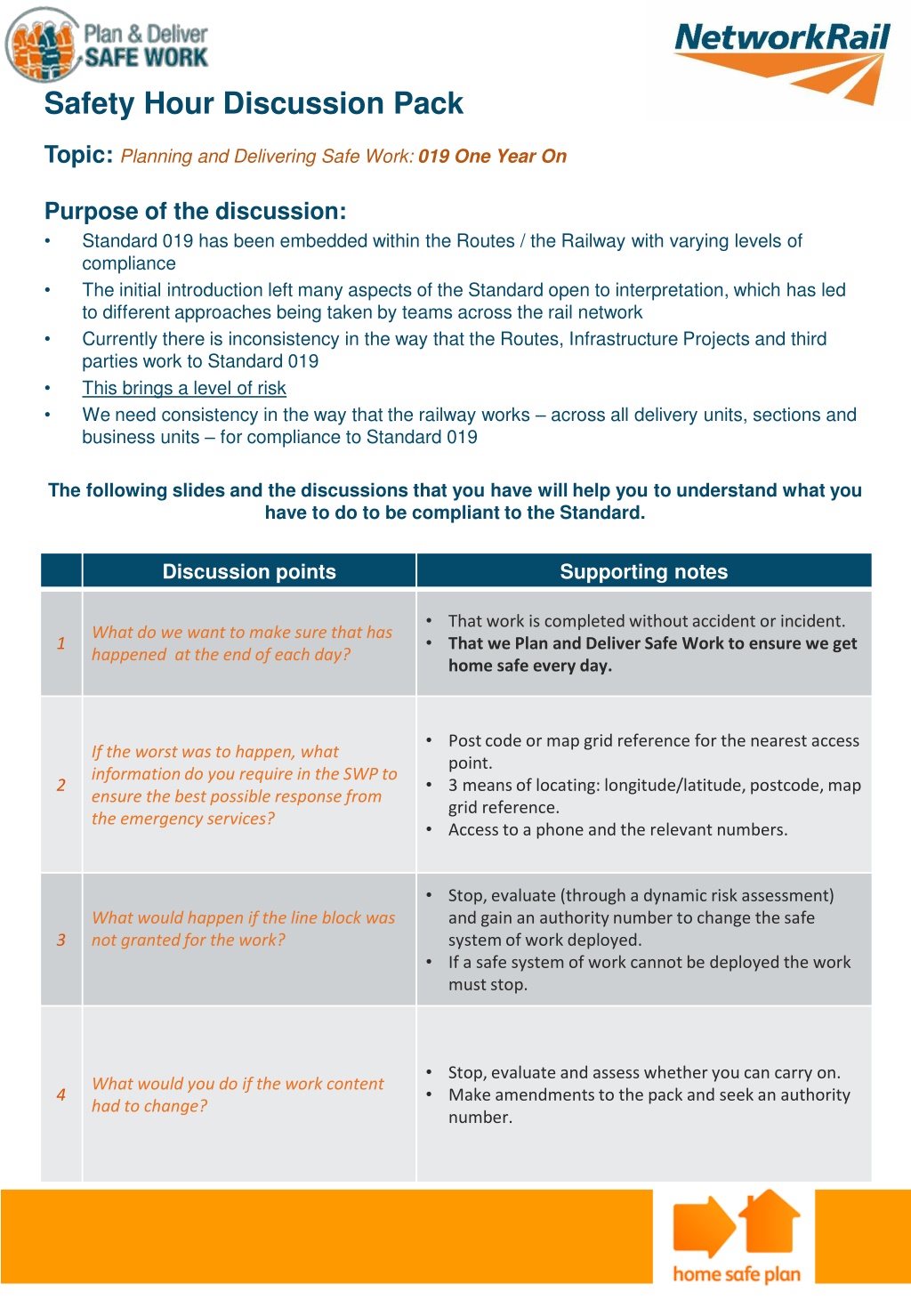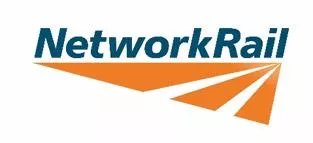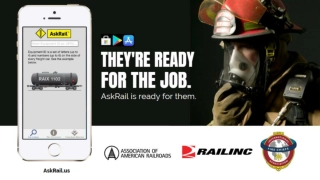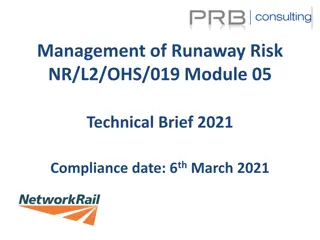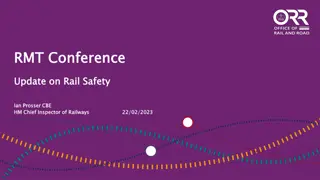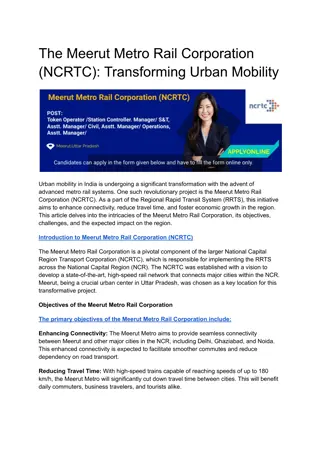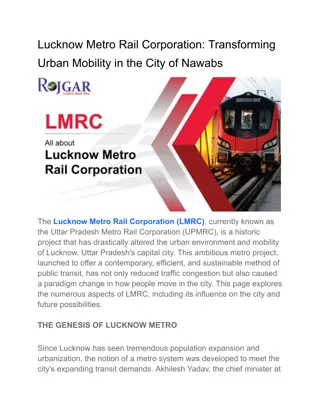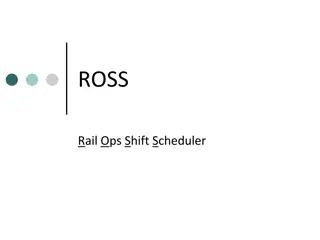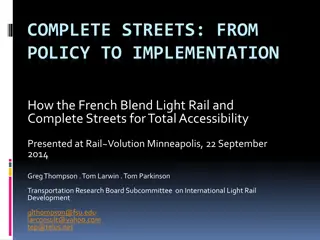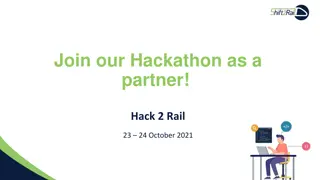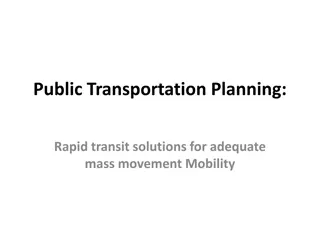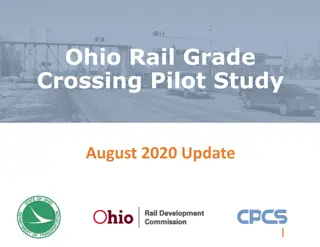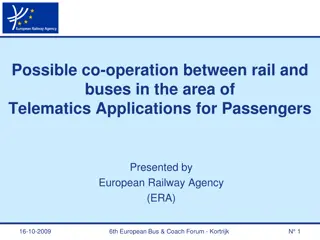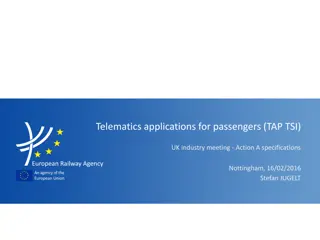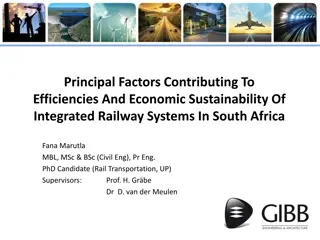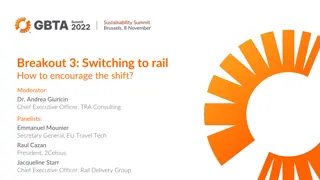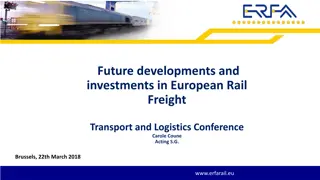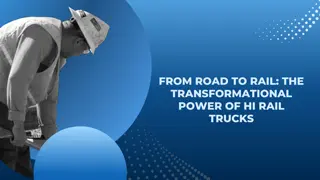Enhancing Compliance with Standard 019 in Rail Operations
Ensure compliance and consistency with Standard 019 in rail operations to minimize risks and enhance safety. Address interpretation discrepancies by establishing clear protocols for planning and delivering safe work. Emphasize the importance of evaluating risks, implementing control measures, and delegating responsibilities effectively to ensure a safe work environment for all personnel involved.
Download Presentation

Please find below an Image/Link to download the presentation.
The content on the website is provided AS IS for your information and personal use only. It may not be sold, licensed, or shared on other websites without obtaining consent from the author. Download presentation by click this link. If you encounter any issues during the download, it is possible that the publisher has removed the file from their server.
E N D
Presentation Transcript
Safety Hour Discussion Pack Topic: Planning and Delivering Safe Work: 019 One Year On Purpose of the discussion: Standard 019 has been embedded within the Routes / the Railway with varying levels of compliance The initial introduction left many aspects of the Standard open to interpretation, which has led to different approaches being taken by teams across the rail network Currently there is inconsistency in the way that the Routes, Infrastructure Projects and third parties work to Standard 019 This brings a level of risk We need consistency in the way that the railway works across all delivery units, sections and business units for compliance to Standard 019 The following slides and the discussions that you have will help you to understand what you have to do to be compliant to the Standard. Discussion points Supporting notes That work is completed without accident or incident. That we Plan and Deliver Safe Work to ensure we get home safe every day. What do we want to make sure that has happened at the end of each day? 1 Post code or map grid reference for the nearest access point. 3 means of locating: longitude/latitude, postcode, map grid reference. Access to a phone and the relevant numbers. If the worst was to happen, what information do you require in the SWP to ensure the best possible response from the emergency services? 2 Stop, evaluate (through a dynamic risk assessment) and gain an authority number to change the safe system of work deployed. If a safe system of work cannot be deployed the work must stop. What would happen if the line block was not granted for the work? 3 Stop, evaluate and assess whether you can carry on. Make amendments to the pack and seek an authority number. What would you do if the work content had to change? 4 /
Safety Hour Discussion Pack Topic: Planning and Delivering Safe Work: 019 One Year On Discussion points Supporting notes The significant risks from the site of work and from the work activity as well as the operational controls, so that the group are not injured from the work activity or endangered by the passage of trains etc. Risk: What risks does the safe work pack identify and what does the PIC do with these? 5 A hazard is something with the potential to cause harm; a risk is the likelihood of that hazard causing harm Risk: What is the difference between a hazard, risk and risk control and give some examples. 6 Known distance to a fixed object or a range finder These are the only reliable ways of determining the distance. Sighting distance requirements depend upon line speed and activity being undertaken Risk: How is the sighting distance worked out on site? 7 You should always test your operational procedure prior to commencing work to ensure that it is satisfactory Risk: How do you make sure your operational risk controls are fit for purpose? 8 You request the task risks and controls for each element of the multi-discipline site of work Each element will then have a nominated risk controller (usually the task lead) in the SWP All elements should be combined into one SWP No You can also use task briefing sheets to identify the risks on site You can also add individual discrete risks and controls to the SWP Risk: How do you gather task risks for a multi-discipline site of work? 9 Risk: Do your task risks have to be written in the form of task risk control sheet? 10 When he is not an expert in it or where the task is multi-disciplined Each task lead- the competent person for undertaking that task who will then be responsible for the risk controls for that task Risk: When does a PIC delegate risk controls and give an example? 11 For further information: Full briefing pack and supporting documents can be found on Safety Central: https://safety.networkrail.co.uk/safety/planning-and-delivering-safe-work/ /
Safety Hour Discussion Pack Topic: Planning and Delivering Safe Work: 019 One Year On Discussion points Supporting notes PIC will brief all on site and identify and implement the relevant controls. Where other teams are delegated control of the risks, they will be allocated control of those risks and brief the group accordingly Controls: How are risk controls implemented? 12 Add them to the pack and brief the team accordingly, then feed back to the planner Do not use uncontrolled documents only use those contained in the information centre Controls: If you identify an additional control is required on the day the work is to take place what do you do? 13 (Unable to provide link to the app. Please locate in App Store) If the pack is inappropriate or insufficient, stop and evaluate the risk If the risk can be controlled in a different way then the PIC should implement the control and record this in the pack If the risk cannot be controlled then work should not take place Controls: What happens if a PIC cannot implement a control? 14 No, the level crossing details are on the RT3181/NR3180 and so it should not be possible to give the block up with the crossing(s) on local control Line Block: Do you require the use of PC if there is one team and a level crossing attendant in a line block? 15 Additional protection should be provided at all times, wherever possible Where the activity affects the safety of the line, you must have additional protection In axle counter areas EPR, Token and Locks and disconnections should be considered before a simple Line Block? Line Block: When do you require additional protection for a line block? 16 For further information: Full briefing pack and supporting documents can be found on Safety Central: https://safety.networkrail.co.uk/safety/planning-and-delivering-safe-work/ /
Safety Hour Discussion Pack Topic: Planning and Delivering Safe Work: 019 One Year On Discussion points Supporting notes The COSS is responsible for making sure the line is fit and safe for trains and communicating to the ES (rule book duties). The PIC is Accountable for making sure the COSS has done this correctly and double checking with the COSS that all staff, materials and objects have been removed from the line and the is line is clear and safe for the passage of trains. The PIC holds overall accountability for the site of work Responsibilities: Who is responsible for ensuring the line is safe for the passage of trains, after undertaking work (other than the Engineering Supervisor)? 17 Responsibilities: What paperwork should a level crossing attendant have? A Safe work pack 18 The person in charge and the planner will collaborate to produce the Safe Work Pack (SWP), which the person in charge will verify This can be done as a face-to-face conversation, phone call, email or through an annotated pack Responsibilities: What is your expectation as a PIC involved in the planning process? 19 These are the responsibilities of a PIC unless operational risk has been delegated to the COSS The pic is accountable for the overall safety of the group on site making sure any responsibilities delegated e.g. COSS duties or specialist task activities have been carried properly. Responsibilities: Who is accountable for the following; keeping the work group safe, the site safe, identified risks controlled, conflict between sites? 20 No, providing they are not exiting the limits of the single line working they control Responsibilities: Does the pilot man need a SWP? 21 Two Responsible Managers/their teams (including PICs) plan work to be complimentary with one another, this may include a discussion to de-conflict Responsibilities: If identified in planning stages that there is a conflict between work groups, what should happen? 22 For further information: Full briefing pack and supporting documents can be found on Safety Central: https://safety.networkrail.co.uk/safety/planning-and-delivering-safe-work/ /
Safety Hour Discussion Pack Topic: Planning and Delivering Safe Work: 019 One Year On Discussion points Supporting notes Check you are in a possession in an ES worksite or A line blockage with additional protection. COSS to Agree with signaller or ES the limits of movement and that no track circuits, treadles or equipment will be affected that could affect LC s (unless on local control) or signal n open lines e.g. if working near a junction. Agree limits of movements and any wrong direction movements to be made. Do not pass any signals showing a red aspect unless you have been given permission by the signaller (or ES in a worksite) Check your SWP for steep gradients highlighted as hazards before placing the trolley on track. Check the brakes before and after placing it on the track, load correctly, red light to be displayed At least 2 staff with it, the competent person has the brake handle If you have a trolley on the track what checks will be undertaken? 23 Pack on the same shift as the work, significant changes to the pack (e.g. change to safe system of work), control can t be implemented (e.g. equipment breakdown) Where the RM has given an authority number the reason for it being given has to be recorded When do you require an authority number? 24 6 years (you only need to keep the parts with the signatures on, the system retains everything else) 25 How long do we keep a SWP for? For further information: Full briefing pack and supporting documents can be found on Safety Central: https://safety.networkrail.co.uk/safety/planning-and-delivering-safe-work/ /
Safety Hour Discussion Pack Topic: Planning and Delivering Safe Work: 019 One Year On FEEDBACK Please fill in the below and share with your Change Leads to provide feedback and understanding on suggestions for improvement to compliance to the 019 standard. Full survey to be completed found here: https://www.surveymonkey.co.uk/r/J87VBJR Question Indicate which depot you have briefed. Which role(s) was your brief delivered to? Choose from the following methods of briefing: safety hour, 1:1, bespoke 019 session, other (please provide detail) Provide the top 3 questions which people had the weakest level of understanding at the start of the session Provide detail as to how you improved levels of understanding in these areas? Provide detail as to how you will continue to check understanding of 019 in your business area? Please provide any other feedback that you received with regards to PDSW/019 during the session. For further information: Full briefing pack and supporting documents can be found on Safety Central: https://safety.networkrail.co.uk/safety/planning-and-delivering-safe-work/ /
